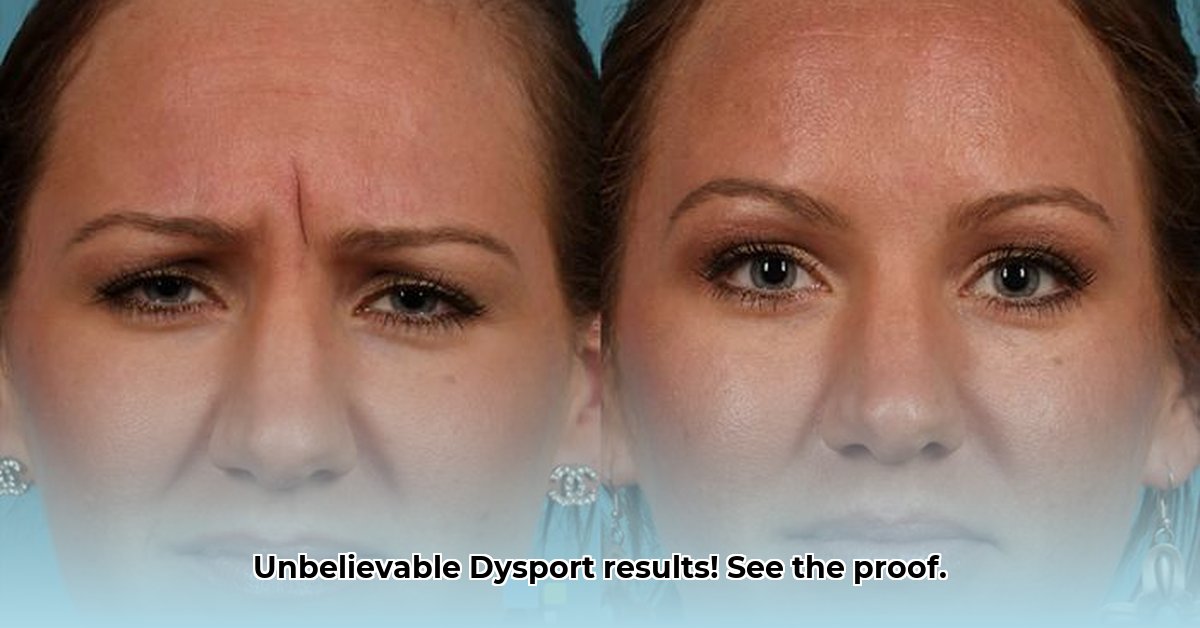Are you considering Dysport to soften wrinkles around your eyes and face? This guide delivers essential information about Dysport, featuring real before-and-after photos and clear explanations of its mechanism. We’ll compare it to Botox, discuss costs, outline the procedure, and cover benefits and potential risks, empowering you to make an informed decision. Our focus is on clarity and avoiding complex medical terms. For more before & after examples, see this helpful resource.
Unveiling Dysport: Achieve Smoother Skin and Reduce Wrinkles
This article provides the information you need to decide if Dysport is the right treatment for you. We will explore how it works, provide real-world examples, discuss benefits, and address potential drawbacks.
The Science Behind Smoother Skin: How Dysport Works
Dysport is a botulinum toxin, similar to Botox. It works by temporarily relaxing facial muscles that cause wrinkles around the eyes (crow’s feet) and between the brows (frown lines). By relaxing these muscles, Dysport reduces the appearance of wrinkles for a more youthful look.
Dysport provides a temporary reduction in the visible signs of aging. The effects wear off over time, so repeat treatments are needed to maintain the results.
Real-World Transformations: A Dysport Before & After Gallery
(Insert high-quality before-and-after photos here. Each photo should have a caption indicating treatment area, duration of effects, and any pertinent details. For example)
-
Image 1 Caption: Significant reduction in forehead lines achieved with Dysport. Results lasted approximately four months.
-
Image 2 Caption: Noticeable improvement in crow’s feet after Dysport treatment. This patient saw results within 48 hours, lasting nearly five months.
-
Image 3 Caption: Impressive reduction of frown lines between the brows. Results lasted approximately three and a half months.
Individual results will vary. The duration of effects depends on factors like metabolism, the amount of Dysport injected, and the area treated.
Benefits and Risks: Is Dysport Right for You?
Studies confirm Dysport’s effectiveness in reducing moderate to severe wrinkles. Like all medical procedures, it has potential risks and side effects. Most are minor and temporary, such as bruising, swelling, or headaches at the injection site, resolving within days.
More serious, and rare, complications can occur, including muscle weakness or breathing difficulties. Therefore, choosing an experienced and qualified injector is crucial. A thorough consultation before treatment is essential.
The duration of Dysport’s effects varies. Some see longer-lasting results than others. More research is needed to understand these differences. It is important to have realistic expectations and anticipate an improvement in the appearance of wrinkles.
Dysport vs. Botox: What’s the Difference?
Dysport and Botox are botulinum toxin type A injectables approved for wrinkle reduction. They work similarly, but subtle differences may influence your choice. Dysport spreads more widely under the skin, potentially leading to a more natural look for some. However, it might slightly increase the risk of affecting unintended muscles.
Dysport may show faster results, with improvements sometimes visible within 24 to 48 hours. However, this isn’t always the case, and both generally take a few days for full effects. The best option depends on individual needs and a discussion with a medical professional.
What to Expect During Your Dysport Treatment
The treatment is quick and minimally invasive. Your doctor will inject Dysport into targeted muscles with a fine needle. There’s usually minimal discomfort, and most people return to normal activities immediately. Avoiding strenuous physical activity for 24 hours is recommended to allow the injection sites to settle.
The cost of Dysport varies by the number of units needed and your location. Discuss pricing with your healthcare provider before treatment. Ask questions to make an informed decision.
Weighing the Pros and Cons of Dysport
Consider these advantages and disadvantages of Dysport:
| Pros | Cons |
|---|---|
| Relatively quick onset of visible improvements | Potential for mild to moderate side effects, such as bruising, swelling, or headache. |
| Minimally invasive procedure | Variability in duration of results; treatment may need to be repeated every few months. |
| Improved appearance of wrinkles | Possible spread of the toxin to unintended muscles (rare). |
| FDA-approved treatment | Requires consultation with a qualified medical professional. |
| May offer a more natural-looking result (anecdotal evidence) | Cost can vary and may not be covered by insurance. |
Is Dysport the Right Choice for You?
Deciding on Dysport treatment is personal. Understand what it can and cannot achieve. It is not a miracle cure, but it can offer a noticeable improvement in the appearance of wrinkles.
Consult with a board-certified dermatologist or plastic surgeon. They can assess your needs and help you decide if Dysport is right for you. Thorough discussion and a skilled injector are keys to a positive experience. Review before-and-after photos, but remember individual outcomes vary.
Dysport vs. Botox: How Long Do Results Really Last?
Key Takeaways:
- Dysport and Botox are injectables that temporarily reduce wrinkles.
- Dysport’s effects often appear sooner, usually within 1-3 days.
- The duration of results varies. Some find Dysport’s effects last up to 5 months, while Botox commonly lasts 3-4 months.
- Both treatments are minimally-invasive.
- Potential side effects are similar: bruising, swelling, and headache. Rare, more serious side effects are possible.
- Dysport often requires a higher dose, altering cost comparisons.
Understanding the Mechanism of Dysport
Dysport, like Botox, is a type A botulinum toxin. It blocks nerve signals that cause muscle contractions and wrinkles. This relaxes the muscles, leading to a smoother appearance. The process involves a small injection to temporarily paralyze targeted muscles. But how long this effect lasts will vary.
Visual Results: Before & After Photos
(Insert a gallery of high-quality before-and-after photos here. Each photo should have a caption indicating the treatment area and the approximate duration of results observed in that individual. For example: “Forehead lines, treated with 50 units of Dysport, results lasted 4 months.”)
Efficacy, Safety, and Potential Side Effects: What to Know
Clinical studies show Dysport is effective in reducing wrinkles. The duration compared to Botox is still being discussed. Some patients report longer-lasting results, while others experience comparable longevity. Individual responses differ. Potential side effects, like Botox, include temporary bruising, swelling, or headache. More serious issues rarely occur. Discuss potential risks with your dermatologist ahead of time.
Dysport vs. Botox: A Detailed Comparison
Both treatments target wrinkles, but they spread differently. Dysport’s effects often spread more widely, which can be an advantage for some areas, but may require a higher dose. Botox may provide more localized results. How long does Dysport last compared to Botox? The answer depends on individual factors. One common advantage cited is a faster onset of action for Dysport– 1-3 days versus 3-5 for Botox.
Cost and Treatment Procedure: What to Expect
The cost of Dysport depends on the number of units needed, areas treated, and clinic location. A consultation assesses your needs and determines a treatment plan. The procedure involves small injections and is generally painless with topical anesthetic. Recovery is minimal, with any swelling or bruising resolving quickly.
Key Questions to Ask Your Provider
Before treatment, ask about potential risks and side effects. Inquire about the expected duration of results and the cost. Discuss your goals and concerns. Choosing a qualified professional is crucial. Use credible sources (like the ones cited in this article) for information prior to your consultation.
- Your Perfect Bento Box Bag For Fresh And Tidy Meals - December 2, 2025
- Korean Meal Prep Made Easy For Delicious Weekday Meals - December 1, 2025
- Korean Food Meal Prep Makes Flavorful Weekday Meals Simple - November 30, 2025










